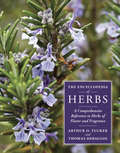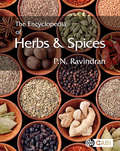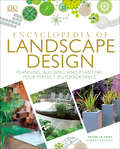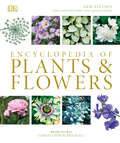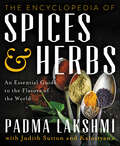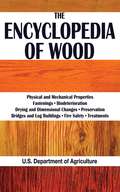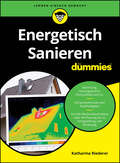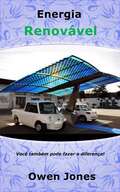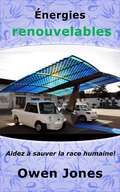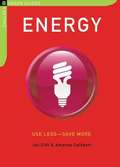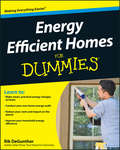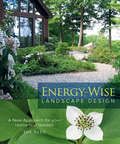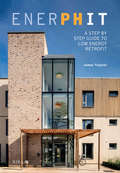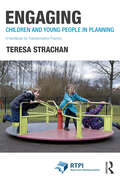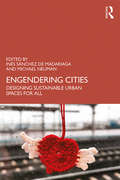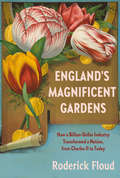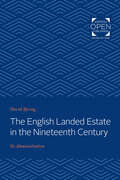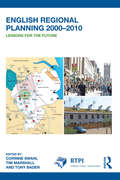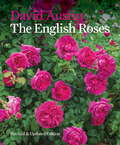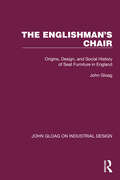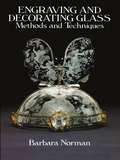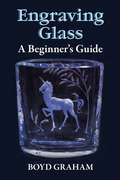- Table View
- List View
The Encyclopedia of Herbs: A Comprehensive Reference to Herbs of Flavor and Fragrance
by Thomas DeBaggio Arthur O. TuckerThis meticulously researched compendium provides every aspect of growing, identifying, harvesting, preserving, and using more than 500 species of herbs. Thorough profiles provide a plant's botanical name and family, whether it is an annual or perennial, its height, hardiness, light requirements, water consumption, required soil type, and pH. The often fascinating history of the plant, the chemistry of its essential oils, and its culinary, landscape, and craft uses are also included, as is advice on how to propagate. For the first edition of their work, both authors received The Gertrude B. Foster Award for Excellence in Herbal Literature from the Herb Society of America. This new edition adds important species and includes updated nomenclature.
The Encyclopedia of Herbs & Spices
by P. N. RavindranThe Encyclopedia of Herbs and Spices provides comprehensive coverage of the taxonomy, botany, chemistry, functional properties, medicinal uses, culinary uses and safety issues relating to over 250 species of herbs and spices. These herbs and spices constitute an important agricultural commodity and are indispensable for pharmaceuticals, flavoring foods and beverages, and in the perfumery and cosmetic industries. More recently, they are increasingly being identified as having high nutraceutical potential and important value in human healthcare. An invaluable reference tool, this book: • Presents easily accessible information, including up-to-date nomenclature and taxonomy • Is beautifully illustrated with over 250 figures • Begins with an introductory chapter on the definition, classification, history, and applications of herbs and spices worldwide • Is written by a well-known authority within the field This encyclopedia is an excellent resource for researchers, students, growers and manufacturers, in the fields of horticulture, agriculture, botany, crop sciences, food science and pharmacognosy.
Encyclopedia of Landscape Design: Planning, Building, and Planting Your Perfect Outdoor Space
by DKTransform your outdoor garden into a picturesque Garden of Eden with this comprehensive garden design encyclopedia!The garden you&’ve always wished for is achievable with this practical gardening bible for all your horticultural needs. Whether you are new to gardening or a seasoned expert, this design book filled with beautiful illustrations and guides will bring all your design ideas to life.From planning to planting, find all the gardening ideas and advice you need to redesign and revamp your garden. Here&’s what you&’ll find inside: • Explains every stage of the design process, from assessing the space to drawing up detailed plans • Showcases a wide range of landscape styles, identifying key elements needed to create the look • Includes a quick-reference visual directory of plants and materials • 32 new pages added, featuring 16 insightful case studies of RHS gold medal-winning landscapes, each analyzed through stunning photographs This landscape design encyclopedia is packed with vital information needed to achieve a healthy, thriving garden. It has valuable advice to guide you from the initial stages of preparation such as choosing the correct materials for your structures and assessing your drainage, to laying patios, making ponds and planting perennials. Discover a magnitude of inspirational portfolios including modernist, sustainable, Japanese, urban, family and cottage gardens to recreate your garden into a modern horticultural masterpiece. Understand the unique features of each garden style, create your own plan and marvel at case studies showcasing the gold standard of each garden type.This stunning landscaping book comes with a visual dictionary and coverage of all the latest gardening trends, and effortlessly combines style with substance to guide you along the way as you plan and plant your perfect outdoor space. It&’s perfect for beginner gardeners and those looking for a bit of inspiration.
Encyclopedia of Plants and Flowers
by Christopher BrickellFind new gardening inspiration with this compelling updated encyclopedia for all gardening enthusiasts!Achieve that beautiful garden oasis you&’ve always dreamed of, and find endless inspiration and guidance for your garden to thrive with this gardening guide! This fully comprehensive yet easy-to-use informative planting guide is what every gardener needs on their bookshelf. Here&’s what you&’ll find inside: • A photographic catalog of 4,000 plants and flowers grouped by type, size, then color, allowing readers to browse and find the best plants for their garden • A detailed &“Plant Dictionary&” describes more than 8,000 species and varieties, and their ideal growing conditions • In the Introduction, a &“Plant Selector&” section lists ideal plants for particular growing conditions, like coastal areas, shady spots and different soil types • Fully updated text from garden plant specialists, with more than 1,380 new plants added, including the latest and most popular cultivars Discover perennials, bulbs, shrubs, trees, succulents and ornamental shrubs, all showcased in beautiful, full-color photography to help elevate your garden to the next level. Use the extensive plant dictionary to look up more than 8,000 plant varieties and the best growing conditions.Written by a team of more than 15 top horticultural specialists under the guidance of internationally renowned gardener and botanist Christopher Brickell, this gardening encyclopedia appeals to all levels of gardeners and continually inspires with achievable garden ideas.This informative yet inspirational book about gardening will appeal to beginners or more experienced gardeners interested in the latest cultivars and horticultural advice.
The Encyclopedia of Spices & Herbs: An Essential Guide to the Flavors of the World
by Padma Lakshmi Judith SuttonFrom the Emmy-nominated host of the award-winning Top Chef, an A-to-Z compendium of spices, herbs, salts, peppers, and blends, with beautiful photography and a wealth of explanation, history, and cooking advice.“A beautiful book by Padma Lakshmi featuring an extensive catalogue and helpful recommendations on how best to use these ingredients to create full-flavored dishes. A great resource for any chef or home cook.” -- Eric RipertAward-winning cookbook author and television host Padma Lakshmi, inspired by her life of traveling across the globe, brings together the world’s spices and herbs in a vibrant, comprehensive alphabetical guide. This definitive culinary reference book is illustrated with rich color photographs that capture the essence of a diverse range of spices and their authentic flavors. The Encyclopedia of Spices and Herbs includes complete descriptions, histories, and cooking suggestions for ingredients from basic herbs to the most exotic seeds and chilies, as well as information on toasting spices, making teas, and infusing various oils and vinegars. And no other market epitomizes Padma’s love for spices and global cuisine than where she spent her childhood—lingering in the aisles of the iconic gourmet food store Kalustyan’s, in New York City.Perfect for the holiday season and essential to any well-stocked kitchen or cooking enthusiast, The Encyclopedia of Spices and Herbs is an invaluable resource as well as a stunning and adventurous tour of some of the most wondrous and majestic flavors on earth.
The Encyclopedia of Wood
by AgricultureTimber is one of our most precious, versatile, and vulnerable resources, so using it effectively is important. Knowing your material inside and out is the first step to doing just that. Read about the structure of wood itself, from growth rings to its chemical composition. Learn wood's physical and mechanical properties, including everything from elasticity to nuclear radiation. This extensive manual includes a section on stress grading as well as thorough descriptions of which fasteners to use and when. It has information on adhesive bonding, biodeterioration, control of moisture content, preservation, fire safety, specialty treatments, and much more. The Encyclopedia of Wood is an essential resource for builders, architects, engineers, and woodworkers.
Energetisch Sanieren für Dummies (Für Dummies)
by Katharina RiedererMachen Sie Ihr Haus zukunftsfit – nachhaltig und energiesparend Wenn Sie Ihr Haus energetisch sanieren möchten, dann liegen Sie mit diesem Buch goldrichtig. Die Autorin begleitet Sie zunächst bei der systematischen Bestandsaufnahme Ihres Hauses. Dabei erhalten Sie wertvolle Informationen und Entscheidungshilfen, die Sie dabei unterstützen, Ihre Sanierungsmaßnahmen zu planen. Sie bekommen Hintergrundinfos und Ausführungstipps zu den einzelnen Maßnahmen, wie beispielsweise zur Sanierung der Gebäudehülle (Stichwort: Dämmung) oder zu technischen Lösungen wie Heizung, Photovoltaik und Co. Damit können Sie Ihr Haus Schritt für Schritt klimafit machen. Sie erfahren Was es mit Energieeffizienz auf sich hat Welche Maßnahmen nötig und welche möglich sind Wie Sie Sonnenenergie nutzen, Heizung, Kühlung und Lüftung planen Wie Sie Ihr Projekt angehen, Vorschriften einhalten und Förderungen erhalten
Energía Renovable: Algunos aspectos de las energías renovables (Cómo hacer... #85)
by Owen JonesEnergía Renovable Algunos aspectos de las energías renovables Espero que la información le resulte útil, precisa y rentable. La información de este libro electrónico sobre cómo implementar una estrategia de energía sostenible en el hogar está organizada en 19 capítulos de aproximadamente 500 a 600 palabras cada uno. Espero que sea de interés para aquellos que quieran hacer algo para crear su propia energía para uso doméstico. Como beneficio adicional, le otorgo permiso para usar el contenido en su propio sitio web o en sus propios blogs y boletines, aunque es mejor si los reescribe primero con sus propias palabras. También puede dividir el libro y revender los artículos. De hecho, el único derecho que no tiene es revender o regalar el libro tal como se le entregó.
Energia Renovável: Você também pode fazer a diferença! (Como faz... #85)
by Owen JonesEnergia Renovável Você também pode fazer a diferença! Espero que ache as informações úteis, convenientes e rentáveis. As informações contidas nesse ebook sobre como implementar uma estratégia para ter energia solar em casa estão organizadas em 19 capítulos de aproximadamente 500-600 palavras cada. Espero que interesse a todos aqueles que gostariam de fazer algo relacionado a criação de energia própria para suas residências. Como bônus incluído, estou concedendo permissão para que use o conteúdo em seu site ou em blogs e newsletter, embora seria melhor que reescrevesse o conteúdo com suas próprias palavras. Você também pode dividir o livro e revender os artigos. Na verdade, o único direito que você não possui é revender ou doar o livro na forma em que o mesmo está sendo entregue a você.
Énergies renouvelables: Aidez à sauver la race humaine! (Comment faire... #85)
by Owen JonesÉnergies renouvelables Aidez à sauver la race humaine! J’espère que vous trouverez ces informations utiles et qu’elles vous permettront de faire des économies. Ce livre numérique aborde la façon de mettre en œuvre une stratégie énergétique durable chez soi. Les informations y sont organisées en 19 chapitres d’environ 500 à 600 mots chacun. J’espère qu’il intéressera ceux qui souhaitent agir en produisant eux-mêmes leur énergie domestique. En prime, je vous donne la permission d’utiliser le contenu de ce livre sur votre site internet, pour vos blogs ou vos bulletins d’information. Il est toutefois préférable que vous les réécriviez d’abord avec vos propres mots. Vous pouvez également sélectionner des articles et les revendre. En revanche, il est interdit de revendre ou de donner le livre tel qu’il vous a été livré.
Energy
by Jon Clift Amanda Cuthbert100 energy saving tips for everything in your home or business. Did you know . . . bull; Heating and cooling account for about 56% of the energy use in a typical home bull; Energy-efficient light bulbs last about 12 times longer than ordinary bulbs, and consume about 1/5 of the energy bull; If we all turned off our TVs and other gadgets that are kept on stand-by, we could shut down a couple of power stations in the United States, with huge reductions in CO2 emissions bull; Our energy use is projected to increase 17% from 1995-2015 bull; Our homes produce even more CO2 emissions than our cars This book gives you 100 energy-saving tips for the home-from simple things like switching off unnecessary lights and having a shower instead of a bath, to more drastic measures such as installing a condensing boiler. If each one of us acts on just a few of these suggestions, we can save money-and help slow down climate change.
Energy: 100 Energy-saving Tips for the Home
by Jon Clift Amanda Cuthbert100 energy saving tips for everything in your home or business. Includes suggestions on heating and cooling, lighting, cooking, appliances and much more. Also provides an overview on renewable energy options.
Energy Efficient Homes For Dummies
by Rik DeguntherHands-on, practical solutions to save money by making smart energy changesOne of the best and most affordable strategies people can employ to combat global warming is to improve the energy and water efficiency of their homes. Energy Efficient Homes For Dummies provides homeowners with advice, tips, and projects to reduce costs, increase energy efficiency, and cut down on waste and pollution. After performing a do-it-yourself home energy audit, readers create an action plan based on their personal goals. Readers are presented with a wide range of potential solutions, from making better use of blinds and awnings to exploring geothermal options in order to reduce household costs and their impact on the planet.Rik DeGunther (Rescue, CA) is the founder of Efficient Homes, an energy consulting firm that focuses on home energy audits and the design of efficient heating and cooling systems.
Energy-Wise Landscape Design
by Sue ReedResidential consumption represents nearly one quarter of North America's total energy use and the average homeowner spends thousands of dollars a year on power bills. To help alleviate this problem, Energy-Wise Landscape Design presents hundreds of practical ways everyone can save money, time, and effort while making their landscapes more environmentally healthy, ecologically rich, and energy efficient.Combining general guidelines with tips, techniques, and actions, this fully illustrated guide explains the many opportunities our landscapes provide for conserving energy. Readers will learn how to: Lower a home's heating and cooling costs Minimize fuel used in landscape construction, maintenance, and everyday use Choose landscape products and materials with lower embedded energy costs Make a positive difference without a major investment or change in lifestyle Intended for homeowners, gardeners, landscape professionals, and students, the design ideas in this book will work in every type of setting--large or small, hilly or flat, urban or rural. Written in non-scientific language with clear explanations and an easy conversational style, Energy-Wise Landscape Design is an essential resource for everyone who wants to shrink their energy footprint while enhancing their property and adding value to their home.Sue Reed is a registered landscape architect and a specialist in ecological landscape design who has helped hundreds of homeowners create comfortable, livable, and beautiful landscapes that save energy. She is also an experienced writer and teacher whose work specifically focuses on environmentally sound, energy-efficient, and sustainable landscape design.
EnerPHit: A Step by Step Guide to Low Energy Retrofit
by James TraynorIn order to meet UK Carbon reduction commitments for 2020 and 2050 building owners will be required to upgrade their buildings to meet an increasingly stringent set of energy performance requirements. In the absence of any clear advice from UK Government on how this can be achieved, the EnerPHit standard offers a very clear methodology. This is a practical guide that gives architects the tools to retrofit buildings to the highest EnerPHit standard. It equips the reader with the key information on EnerPHit (as the most effective benchmark for performance), the practical know-how and tips to ensure effective retrofit throughout all Plan of Work stages of a project to the EnerPHit standard. Backed with real-life case studies, it enables you to understand how to achieve successful outcomes tailored to suit available budgets and programmes.
Engaging Children and Young People in Planning: A Handbook for Transformative Practice (ISSN)
by Teresa StrachanEngaging Children and Young People in Planning places planners’ skills for engagement with children and young people centre stage by discussing several projects delivered or supported by planning students to young people in the Northeast of England. Urban or town and country planning is a largely unfamiliar concept to children and young people. Moreover, in England, the environment in which young people live, play and go to school is shaped by a local planning process which lacks their input. This book explores the nature of the gap between that planning process and the voice of the younger members of the community, as well as the barriers that impede this engagement. It highlights why an engagement process is beneficial for those young people, for the wider community and for the planning process itself. At a time when our relationship with and impact on, the environment is being re-examined, this book challenges the planning professional to identify, develop and reflect upon the engagement skills that will help to transform planning into a more inclusive practice. It will be of use to scholars and practitioners in urban planning, community planning, engagement and children’s rights, whilst supporting their academic and professional development pathways.
Engendering Cities: Designing Sustainable Urban Spaces for All
by Inés Sánchez de MadariagaEngendering Cities examines the contemporary research, policy, and practice of designing for gender in urban spaces. Gender matters in city design, yet despite legislative mandates across the globe to provide equal access to services for men and women alike, these issues are still often overlooked or inadequately addressed. This book looks at critical aspects of contemporary cities regarding gender, including topics such as transport, housing, public health, education, caring, infrastructure, as well as issues which are rarely addressed in planning, design, and policy, such as the importance of toilets for education and clothes washers for freeing-up time. In the first section, a number of chapters in the book assess past, current, and projected conditions in cities vis-à-vis gender issues and needs. In the second section, the book assesses existing policy, planning, and design efforts to improve women’s and men’s concerns in urban living. Finally, the book proposes changes to existing policies and practices in urban planning and design, including its thinking (theory) and norms (ethics). The book applies the current scholarship on theory and practice related to gender in a planning context, elaborating on some critical community-focused reflections on gender and design. It will be key reading for scholars and students of planning, architecture, design, gender studies, sociology, anthropology, geography, and political science. It will also be of interest to practitioners and policy makers, providing discussion of emerging topics in the field.
Engineering for Cats: Better the Life of Your Pet with10 Cat-Approved Projects
by Mac DelaneyThere may be 100 million pet cats in this country, but who says that means they’re domesticated? Sure, they clean themselves, use a litter box, and hunt rodents, but cats are also territorial beasts who think furniture is meant for claw sharpening, and that running water is always better than still. In this inventive, surprisingly funny, and highly entertaining and practical book, Mac Delaney addresses the quirks of cat behavior through the mindset of an aerospace engineer (because that’s what he is!)—and gives us 10 projects that solve the most common sources of friction affecting cats and their doting owners. Take that preference for running water. Because cats don’t trust still water (in the wild, a stagnant pool can harbor disease), they’re often dehydrated and cranky. Here’s how to build not one but two different fountains that will provide fresh, moving water. Or another problem: Cats, diminutive in stature, can feel inferior around humans, causing them to act out in negative ways. The solution: Erect a cat shelf on your wall, giving your pet a prime perch and a height advantage. And that furniture scratching problem? Construct the Cat Cave—it has angled surfaces for optimal scratching, a curved top for ergonomic lounging, a carpeted interior for perfect napping, and an escape route out back for emergency exits. For any cat lover with a modicum of DIY skills, here’s a whole new approach to living happily ever after with your pet(s).
England's Magnificent Gardens: How a Billion-Dollar Industry Transformed a Nation, from Charles II to Today
by Roderick FloudAn altogether different kind of book on English gardens—the first of its kind—a look at the history of England&’s magnificent gardens as a history of Britain itself, from the seventeenth-century gardens of Charles II to those of Prince Charles today. In this rich, revelatory history, Sir Roderick Floud, one of Britain&’s preeminent economic historians, writes that gardens have been created in Britain since Roman times but that their true growth began in the seventeenth century; by the eighteenth century, nurseries in London took up 100 acres, with ten million plants (!) that were worth more than all of the nurseries in France combined. Floud&’s book takes us through more than three centuries of English history as he writes of the kings, queens, and princes whose garden obsessions changed the landscape of England itself, from Stuart, Georgian, and Victorian England to today&’s Windsors. Here are William and Mary, who brought Dutch gardens and bulbs to Britain; William, who twice had his entire garden lowered in order to see the river from his apartments; and his successor, Queen Anne, who, like many others since, vowed to spend little on her gardens and instead spent millions. Floud also writes of Frederick, Prince of Wales, the founder of Kew Gardens, who spent more than $40,000 on a single twenty-five-foot tulip tree for Carlton House; Queen Victoria, who built the largest, most advanced and most efficient kitchen garden in Britain; and Prince Charles, who created and designed the gardens of Highgrove, inspired by his boyhood memories of his grandmother&’s gardens. We see Sarah, Duchess of Marlborough, who created a magnificent garden at Blenheim Palace, only to tear it apart and build a greater one; Deborah, Duchess of Devonshire, the savior of Chatsworth&’s 100-acre garden in the midst of its 35,000 acres; and the gardens of lesser mortals, among them Gertrude Jekyll and Vita Sackville-West, both notable garden designers and writers. We see the designers of royal estates—among them, Henry Wise, William Kent, Humphrey Repton, and the greatest of all English gardeners, &“Capability&” Brown, who created the 150-acre lake of Blenheim Palace, earned millions annually, and designed more than 170 parks, many still in existence today. We learn how gardening became a major catalyst for innovation (central heating came from experiments to heat greenhouses with hot-water pipes); how the new iron industry of industrializing Britain supplied a myriad of tools (mowers, pumps, and the boilers that heated the greenhouses); and, finally, Floud explores how gardening became an enormous industry as well as an art form in Britain, and by the nineteenth century was unrivaled anywhere in the world.
The English Landed Estate in the Nineteeth Century: Its Administration
by David SpringOriginally published in 1963. The English Landed Estate in the Nineteeth Century: Its Administration deals principally with the administration of large landed estates during the years from 1830 to 1870. The book also throws new light on the work of the Inclosure Commissioners, who, as a department of the central government, supervised agricultural improvements made by landowners who borrowed from the government and from land companies. Author David Spring argues that the British government intervened in agriculture much more than is commonly thought. In describing the hierarchy of estate management, Spring relies, wherever possible, on hitherto unused family papers and estate documents. Especially important is his material on the Dukes of Bedford and on the domestic economy and financial position of the Russell Family. The chapter titled "The Landowner," based on the seventh Duke of Bedford's correspondence with his agent, is a case study of a single estate and provides insight into the workings of a great landowner's mind. The remaining chapters, dealing with lawyers, land agents, and the Inclosure Commissioners, include other individual portraits. Among these are Christopher Haedy, the Duke of Bedford's chief agent; James Loch, king of estate agents in nineteenth-century England; Henry Morton, the Earl of Durham's land agent; and William Blamire and James Caird, two of the Inclosure Commissioners.
English Regional Planning 2000-2010: Lessons for the Future (RTPI Library Series)
by Tim Marshall Corinne Swain Tony BadenEnglish Regional Planning 2000-2010 chronicles a vital feature of recent UK planning activity, during the period of the Blair and Brown Labour governments up to 2010. It deals particularly with the regional scale of planning during these years, whereby large steps forward were made, but where policy making often proved very controversial. One purpose of the book is to learn from the many areas of policy development, method and skills which evolved during the decade up to 2010. This will mean that a future return to strategic planning should not have to reinvent the wheel. This book also helps to inform such planning in the rest of the developed world where higher-level planning is more prevalent. The book has eight chapters written by experts active in English regional planning during these years, alongside two chapters by the editors introducing and concluding on the experience as a whole. Thematic topics covered include the way in which housing and employment development was tackled in the varying English regional contexts, and the growing influence of transport and environmental factors on the spatial strategy. Process elements covered include how policy was made through public consultation and working with numerous stakeholders (economic, social, environmental), how the public examination of issues was organised, followed by final consideration by central government, and how monitoring informed the next policy review. The authors do not gloss over the difficulties encountered in the highly contested world of English local and regional politics, or the ways in which central government management of the regional planning process made life on the ground difficult for those engaged in the process. Nevertheless the account as a whole shows how a wealth of innovative and forward looking practices were developed. This multi-faceted study contributes to the understanding of how strategic planning can provide the framework for guiding spatial change and allocating resources, looking to a long-term sustainable future.
The English Roses: Climbing, English, Shrub, Hybrid Teas And Old Roses
by David AustinDavid Austin Roses is one of the world's leading rose nurseries. The English Roses developed there have brought the rose to a new level of beauty and strength; their ability to flower continually throughout the summer and autumn makes them one of the most durable garden flowers.In this revised and updated edition, David Austin describes how he combines the beauty and fragrance of the Old Roses with the repeat-flowering and wide colour range of the Modern Roses. David presents seven groups of classification for his roses and advises how to grow and maintain them.Featuring more than 20 new rose varieties, all with detailed descriptions and updated photography throughout, this third revised edition of The English Roses is an essential reference for all rose lovers and gardeners.
The Englishman's Chair: Origins, Design, and Social History of Seat Furniture in England
by John GloagOriginally published in 1964, The Englishman’s Chair is a history of English chairs, written as a continuous story from the 15th to the 20th Century and because of the revealing powers inherent in chair-making and design, it is also an unconventional footnote to English social history. The changes in taste, and fashion, the increase of skill, the introduction of new materials and the long battle between dignity and comfort are discussed, as is the impact that modern industrial designers have had on chair design.
Engraving and Decorating Glass: Methods and Techniques
by Barbara NormanThe history of glass and glass decoration extends back at least to the ancient Egyptians, who made small vessels of dark glass and decorated them with glass threads of contrasting colors. Occasionally glass vessels were also engraved on the lapidary's wheel. Today, the ancient art and craft of decorating glass continues to flourish among artists and crafters attracted by its combination of artistic beauty and skilled craftsmanship. Unfortunately, until the publication of this book, there were few if any practical instruction guides for beginners in this exciting and deeply rewarding field.A well-known British artist and glass engraver, Barbara Norman has exhibited her glass widely and has won numerous awards. In this clear, profusely illustrated guide, she offers a comprehensive introduction to the history, materials, tools, and techniques of glass engraving and other forms of glass decoration.After introductory chapters on the development of glass, methods of glassmaking, decorating techniques and choosing glass, the author discusses various engraving techniques in detail: diamond point engraving, drill engraving, and copper-wheel engraving. Aspiring glasscrafters will also find excellent coverage of such interesting techniques as gold engraving under glass, painting glass, and applying glass to glass: mosaics, glass collage, glass fusing and glass forming. Most of the methods do not require a studio or workshop and call for relatively inexpensive materials.Ideal for the novice or moderately experienced glassworker, this well-written, easy-to-follow guide will enable glasscrafters to bring decorative beauty and artistic flair to glasses, tumblers, bowls, vases, plates -- almost any glass object. Beautiful engraved or decorated glass is perfect for personalized gift-giving or for adding a note of elegance to any home.
Engraving Glass: A Beginner's Guide
by Boyd Graham"Lucidly written and illustrated." — The Glass EngraverIf you've ever admired the exquisite beauty and craftsmanship of Steuben, Tiffany, Orrefors, or other fine engraved glass and wished you could engrave glass yourself, this book is for you. It provides step-by-step instructions for diamond-bur engraving, from making the first cut to displaying the finished work.The author, a prize-winning engraver, provides a detailed summary of tools and equipment you will need and suggestions for setting up your workshop, along with easy-to-follow practice exercises to give you a feel for working with glass and glass-engraving equipment. Mr. Graham then guides students through four complete projects, ranging from a simple tree design to a more complex flower engraving.Here are other practical features that make this book ideal for the novice: a useful discussion of design considerations and applications, review of supplemental tools and advanced techniques, expert advice on choosing glass, suggestions for the arrangement and lighting of finished pieces, and more. Over 100 helpful illustrations enhance the text.With this inexpensive book as your guide, you'll find learning the fundamentals of glass engraving far easier than you might have imagined. Simply written and easy to understand, Engraving Glass: A Beginner's Guide is your personal invitation to enjoy the challenges and satisfactions of this rewarding craft.
